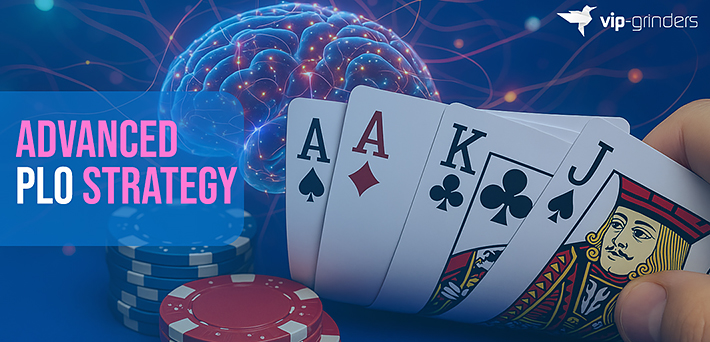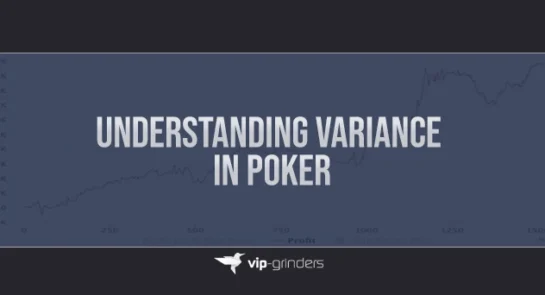Advanced PLO: Nut Hand Focus and Variance

Theoretical Foundations: The Nut Advantage
PLO hands have equities that run much closer together than in NLHE. This means you must prioritize hands that can realize the nut or block your opponent from realizing theirs.
Nut-Blocking Frequency (NBF)
NBF is the quantification of a hand’s ability to remove key card combinations (blockers) that an opponent needs to make the nut hand or a top draw. Using NBF is critical for credible bluffing and defending.
| Board Texture | Optimal Blocker (Example) | Aggression Rationale |
| Monotone Flop (A♡T♡5♡) | Holding A♠K♡XX (Nut Flush Blocker) | Prevents opponent from having K♡Q♡ or Q♡J♡ to call/raise your C-bet. |
| Two-Tone, Straight-Heavy (9♠T♠J♢) | Holding K♠Q♢XX (Nut Straight Blocker) | Blocks the Axxx nut straight and many gut-shot redraws. |
| Paired Board (Q♠Q♢4♡) | Holding Q♡A♠K♢2♠ (Nut Boat Blocker) | Blocks most nutted full house combos (QQxx with Aces). |
Key Takeaways on Blockers in Omaha:
- Blockers are used to bluff strong ranges: Unlike NLHE, you bluff with blockers in PLO not just to fold out air, but to make strong made hands (like two pair or a weaker set) fold because your opponent assumes you have a nut-heavy range.
- Blockers dictate post-flop sizing: When you hold a nut blocker, you can often use a larger bet size (like an overbet) because you’ve significantly capped the number of nuts your opponent can hold.
Nut-Implied vs. Reverse Nut-Implied Odds (RNIO)
- Nut-Implied Odds: When your nut draw hits, the probability your opponent has a strong, non-nut hand (e.g., second nut, strong set) to pay off your big bet. You want hands that maximize this.
- Reverse Nut-Implied Odds (RNIO): The catastrophic cost of having a strong non-nut hand that is a massive underdog to the true nuts (e.g., flopping a set on a monotone board without a flush redraw).
- Advanced Omaha Hand Selection: Avoid hands that are prone to RNIO, like hands that make only the bottom or middle end of a straight (e.g., 5−6−7−8). Prioritize hands that create dominated nut possibilities (e.g., an Ace in a rundown for the nut straight).
Pre-Flop: Constructing Nut Ranges
Advanced Pot-Limit Omaha pre-flop strategy is about building ranges that guarantee nut-equity coverage on the most common board textures.
Deep-Stack Range Construction (200BB+)
When stacks are deep, playability (the ability to make the nuts/nut draws) trumps raw pre-flop equity.
| Hand Category | Preferred Structure (Example) | Rationale |
| Double-Suited Aces | A♡A♢K♡Q♢ | Highest raw equity, but also maximizes nut straight/flush redraws. Low RNIO. |
| Connected Wraps | T♠J♡Q♠K♡ (Double-Suited Rundowns) | Flops massive 16-20 out nut/nut-redraw wraps. Highly efficient equity realization. |
| ‘Nutty’ Blockers | A♡K♡J♠9♢ (Gapped, Suited Ace) | Good enough equity to see the flop and blocks the nut flush. Excellent for 3-bet bluffing. |
Positional Blockers and Pot-Limit Sizing
3-Betting with Blockers: Use Axxx hands (with good connectedness but not elite raw power) as primary 3-bet bluffs in position. They deny the opponent a nut flush blocker and play well when the board is coordinated.
- Cap Sizing: In deep stacks, pre-flop bet sizing (especially 3-bets) should be carefully calculated to manipulate the Stack-to-Pot Ratio (SPR).
- A large 3-bet (e.g., 4.5x to 5x) creates a low SPR (<5 on the flop) for strong nut hands (like AAxx) to get all-in on the flop.
- A smaller 3-bet (e.g., 3.5x) maintains a high SPR, favoring speculative hands that prefer to see the turn and river with their big draws.
Post-Flop Strategy: Leveraging Nut-Dominance
C-Betting and Delayed Aggression
C-Betting with Air/Blockers: On wet, high-texture flops, your continuation betting range should be highly polarized. You bet with the nuts/nut draws and with hands that are pure air but hold critical nut blockers.
- Example: On Q♡T♡7♠, betting with A♡9♢xx (Nut Flush Blocker, no pair/draw) forces the opponent to fold hands they otherwise might have called with, or makes them defend without the nut flush draw.
Delayed C-Betting (Turn/River): This is a key solver-approved tactic in PLO. Checking the flop with nut-draws or medium-strength hands allows you to exploit the opponent’s tendency to under-bet the turn. When they check back, the turn is often the right time to fire a large bet, representing a strong range they’re now capped against.
Value and Bluffing with Overbets
In PLO, the cap on an opponent’s calling range is often higher, justifying larger value bets.
| Situation | Action | Rationale |
| River Nuts with Few Draws | Overbet (125-150% Pot) | Exploit players who will call strong hands (2nd nuts, big full houses) regardless of bet size. Only feasible when your range is truly polarized to the nuts/air. |
| Nut Draw on Flop/Turn | Check-Raise Pot | Generates maximum fold equity by representing a made nut hand, forcing opponents to fold their weaker equity/draws. |
| Triple-Barrel Bluff | River Overbet with Nut Blocker | If you miss the nut draw but hold a key blocker, the large bet sells the story that you hit and are protecting the nut value. |
Understanding and Mitigating PLO Variance
PLO’s high number of hand combinations and close equities mean that even in 70/30 situations, you will lose frequently. This translates to a significantly higher Standard Deviation (SD) than NLHE.
| Metric | NLHE (Approx.) | PLO (Approx.) | Implication |
| Best Pre-Flop Equity | AA vs Any Hand ≈85% | AAXX vs Any Hand ≈65% | Equity is much flatter, leading to more frequent ‘coolers’ and bad beats. |
| Standard Deviation (SD) | ∼80BB/100 hands | ∼150BB/100 hands | Greater deviation from Expected Value (EV) over the short run. |
| Expected Downswing | ∼20−30 Buy-ins | ∼80−100+ Buy-ins | You must be financially and mentally prepared for prolonged losses. |
Advanced Bankroll Management in Pot-Limit Omaha
The high SD requires a much more conservative BRM than NLHE:
- Minimum BRM: A winning PLO professional should generally maintain a minimum of 80-100 buy-ins for their limit, especially if they are multi-tabling or playing aggressively.
- Tilt Control: High variance inevitably leads to significant emotional stress. Advanced players use pre-defined stop-loss limits (e.g., “I stop playing after I lose 3 buy-ins, regardless of how I feel”) to prevent tilt from compounding statistical variance with behavioral errors.
- Run It Twice (RIT): Strategically agree to RIT in 60/40 or 70/30 all-in situations to reduce immediate outcome volatility and smooth out hourly results, protecting your short-term mental state and bankroll. The best Omaha poker sites all offer a variation of RIT.
Key Takeaways for Advanced Pot-Limit Omaha Strategy
- Prioritize Nuttiness: Always play hands that can make the nut or block your opponent from making it. Devalue hands that only make the second or third best hand.
- Blockers are Bluffing Gold: Use Nut-Blocking Frequency (NBF) to justify large bluffs and C-bets on coordinated boards. A bluff with a blocker is far more profitable than a bluff with no card removal effect.
- Manage SPR: Manipulate pre-flop bet sizing to achieve a desired Stack-to-Pot Ratio (SPR) on the flop, making it easy to stack off with strong hands or keep the pot small with drawing hands.
- Exploit RNIO: Be ruthless in exploiting opponents who call too wide pre-flop with hands prone to Reverse Nut-Implied Odds (hands that make strong, but non-nut, hands).
- Respect the Swings: Acknowledge that 80-100 buy-in downswings are mathematically normal in high-level PLO. Implement strict BRM and tilt-control measures to protect your career.
Advanced Pot-Limit Omaha Strategy FAQs
What is "Nut-Blocking Frequency" and how do I use it in my strategy?
Nut-Blocking Frequency is an advanced concept that quantifies the probability of your hole cards denying an opponent the absolute best possible hand (the “nut”) on a specific board texture. You use it primarily for bluffing and semi-bluffing on the river or turn.
How does the concept of "Reverse Nut-Implied Odds (RNIO)" change my pre-flop hand selection?
RNIO refers to the likelihood of losing a massive pot because you are drawing to the second-best nut (or a very strong, but non-nut, hand) and getting stacked by the true nut.
What is a realistic expectation for variance in high-stakes PLO compared to No-Limit Hold'em (NLHE)?
PLO’s variance (measured by standard deviation or SD) is typically 2 to 4 times higher than NLHE for players with a similar win rate (in Big Blinds per 100 hands, BB/100).
When should I use an overbet (more than the pot size) with the nuts in PLO?
Overbetting the river with the nut hand is an advanced, high-EV play used to exploit opponents’ tendencies to over-call or to maximize against players who will only call large bets with specific combinations of the second or third nut.
How should my strategy change in Multi-Way Pots (MWP) when I have the nut draw?
In MWP, the nut draw has two key strategic shifts:
Prioritize Protection: With more players, the odds of a cheaper draw or a weaker made hand improving to beat you increases. You must be more aggressive to fold out or charge draws, even with a strong draw yourself.
Higher Implied Odds: Because more players will have money invested when you hit your nut, your implied odds are massive. This justifies calling larger bets than you would heads-up, provided you can realize your equity and don’t have severe RNIO.



















